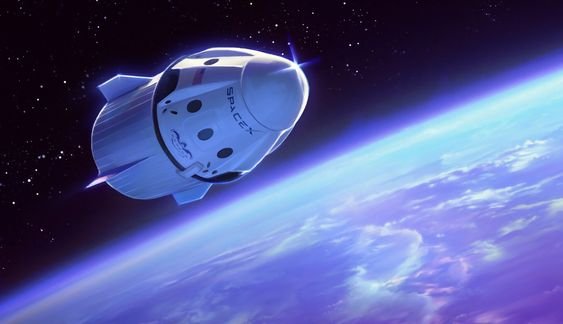
On a pre-dawn Tuesday morning, a crew of four private astronauts will embark on a historic and high-risk mission with SpaceX, aiming to complete the first-ever private spacewalk. This ambitious endeavor, part of the “Polaris Dawn” mission, is set to push the boundaries of private space travel and challenge the status quo, which has been dominated by government space agencies for decades.
The mission will launch from NASA’s Kennedy Space Center in Florida aboard SpaceX’s Crew Dragon capsule, a spacecraft known for its advanced design and functionality. It represents SpaceX’s fifth private space mission, and arguably the most perilous, as it includes the first commercial spacewalk and the farthest human travel from Earth since the Apollo missions ended in 1972.
The Crew and the Mission Objectives
The Polaris Dawn mission is financed by Jared Isaacman, a 41-year-old billionaire entrepreneur and founder of the electronic payment company Shift4. Isaacman, an accomplished pilot who previously funded and commanded the Inspiration4 mission in 2021, continues to pioneer new territory in private space exploration. He is joined by mission pilot Scott Poteet, a retired US Air Force lieutenant colonel, and two senior SpaceX engineers, Sarah Gillis and Anna Menon, who bring technical expertise and firsthand experience with the Crew Dragon spacecraft.
The crew’s primary objective is to perform the first private spacewalk, which is scheduled to occur on the third day of their five-day mission. During this spacewalk, Isaacman and Gillis will exit the Crew Dragon capsule while tethered to oxygen lines, relying entirely on SpaceX-built spacesuits for life support. Poteet and Menon will remain inside the cabin to oversee operations and provide support.
In addition to the spacewalk, the mission aims to conduct a series of scientific experiments that will study the effects of cosmic radiation and the vacuum of space on the human body. This research will contribute to decades of data gathered from astronauts aboard the International Space Station (ISS) and help prepare for longer missions, such as those to the Moon and Mars.
Challenges and Risks of the Polaris Dawn Mission
1. A Complex Launch Environment
The Polaris Dawn mission has faced a series of challenges leading up to its scheduled launch. An initial attempt to launch last month was postponed due to a small helium leak in the ground equipment at SpaceX’s launchpad. Although the leak was quickly repaired, the mission faced further delays when the Falcon 9 rocket was grounded by US regulators following a booster recovery failure during an unrelated mission.
Now cleared to fly, the Polaris Dawn mission is set for a pre-dawn launch with a narrow 40% chance of favorable weather conditions, according to the US Space Force’s launch weather modeling. SpaceX has backup launch windows later in the morning if necessary, but the unpredictable weather adds another layer of complexity to an already risky mission.
2. The Risks of a Commercial Spacewalk
While spacewalks are a routine part of operations for highly trained government astronauts on the ISS, this will be the first time a commercial crew attempts such a maneuver. Historically, spacewalks have only been performed by astronauts from government space agencies, with roughly 270 spacewalks conducted on the ISS since its creation in 2000, and 16 by Chinese astronauts on Beijing’s Tiangong space station.
The spacewalk is planned for the mission’s third day at an altitude of approximately 700 km (435 miles), which is significantly higher than the ISS’s orbit of about 400 km (248 miles). During the spacewalk, the Crew Dragon capsule will slowly depressurize its entire cabin, as it lacks an airlock like the ISS. All four astronauts will rely on their slimmed-down SpaceX-built spacesuits for oxygen, presenting a new set of risks and challenges.
The procedure planned for Polaris Dawn is reminiscent of the first U.S. spacewalk in 1965, which took place aboard a Gemini capsule. In that mission, the capsule was depressurized, the hatch opened, and an astronaut ventured outside tethered to the spacecraft. While the basic concept remains the same, the execution is now in the hands of a private company rather than a national space agency.
Technological Innovations and Preparations
SpaceX’s Crew Dragon spacecraft, which will transport the Polaris Dawn crew, represents the pinnacle of modern spacecraft design. Since NASA retired the Space Shuttle in 2011, Crew Dragon has become the primary vehicle for transporting astronauts to and from the ISS, successfully completing nine missions to date for NASA, along with several private missions.
For Polaris Dawn, SpaceX has redesigned certain aspects of the spacecraft and developed new spacesuits specifically for this mission. These suits are tailored for greater flexibility and mobility, allowing astronauts to perform more complex tasks during the spacewalk. They also incorporate advanced life-support systems, including oxygen lines and temperature control, essential for maintaining astronaut safety in the harsh environment of space.
Scientific Goals and the Human Element
The Polaris Dawn mission is not just a bold adventure in private space travel; it also serves as a scientific expedition. The crew will serve as test subjects for a range of experiments that aim to deepen our understanding of how cosmic radiation and microgravity affect human physiology. These experiments are designed to provide valuable data that could inform future long-duration missions to the Moon, Mars, and beyond.
1. Studying Cosmic Radiation and Microgravity Effects
One of the key experiments on this mission involves studying the impact of cosmic radiation on the human body. At an altitude of 700 km, the crew will be exposed to levels of radiation significantly higher than those experienced on the ISS or during low Earth orbit flights. Understanding how this radiation affects the human body is critical for planning longer-duration missions to the Moon or Mars, where astronauts would be exposed to such radiation for extended periods.
2. Preparing for Future Space Exploration
The data collected during Polaris Dawn will add to the growing body of knowledge about human health in space, which has been accumulated over decades of research on the ISS. This research is crucial for preparing astronauts for future missions beyond Earth’s orbit, where they will be further from medical support and exposed to greater risks.
A Vision for the Future: The Polaris Program
The Polaris Dawn mission is the first in a series of planned missions under the Polaris Program, which aims to push the boundaries of human space exploration through private-sector innovation. Jared Isaacman, the mission’s financier, has ambitious plans for the program, which include a follow-on Crew Dragon mission and a future flight aboard SpaceX’s Starship—a giant rocket currently in development and intended for deep space exploration.
Isaacman’s vision for the Polaris Program extends beyond just proving the viability of private spacewalks. He aims to establish a platform for routine private space missions that can complement and enhance the efforts of national space agencies like NASA. The program is also intended to help SpaceX refine its technologies and procedures, making human spaceflight more accessible and sustainable.
SpaceX’s Role in the Evolving Space Industry
Since its founding in 2002, SpaceX has rapidly become a dominant player in the space industry. It has disrupted traditional space exploration models by lowering launch costs, developing reusable rockets, and fostering innovation. The company’s Crew Dragon spacecraft has been the only US crew-grade vehicle in operation since the retirement of the Space Shuttle, and it has flown numerous missions for NASA and private clients.
The Polaris Dawn mission represents the next step in SpaceX’s evolution, demonstrating the company’s capability to conduct complex operations like spacewalks, which have traditionally been the domain of government space agencies. Elon Musk, SpaceX’s CEO, has often stated that his ultimate goal is to make space travel more accessible, with the eventual aim of colonizing Mars.
Competitive Landscape: Boeing’s Struggles and SpaceX’s Lead
While SpaceX continues to innovate and expand its capabilities, competitors like Boeing are struggling to keep pace. Boeing’s Starliner spacecraft, intended to rival the Crew Dragon, has faced numerous setbacks, including delays and technical issues. The Starliner’s latest NASA test mission, which began in June, left its astronauts on the ISS due to propulsion system problems. These issues have highlighted SpaceX’s lead in the commercial space race and underscored its importance as a partner for NASA and other space agencies.
The Future of Private Space Exploration
The Polaris Dawn mission is a significant milestone in the ongoing evolution of private space exploration. As private companies like SpaceX take on increasingly complex missions, the line between government and commercial space endeavors continues to blur. The success of Polaris Dawn could pave the way for more private missions, including those to the Moon, Mars, and beyond.
However, with greater ambition comes greater risk. The mission’s success will depend on a range of factors, from weather conditions at launch to the performance of the Crew Dragon spacecraft and the new spacesuits. As Elon Musk noted, “Crew safety is absolutely paramount, and this mission carries more risk than usual.” Nonetheless, the potential rewards, both in terms of scientific knowledge and commercial opportunity, are immense.
Conclusion: A Bold New Chapter in Space Exploration
As the Polaris Dawn mission prepares for liftoff, it marks a bold new chapter in space exploration—one where private citizens, funded by private capital, venture further from Earth than any human has since the Apollo program. The mission’s success could redefine our understanding of what is possible in space, opening new frontiers for exploration and setting the stage for an exciting future where private and public sectors collaborate to explore the cosmos.
Whether the mission succeeds or faces unforeseen challenges, Polaris Dawn represents a significant step forward in the democratization of space travel, proving that the final frontier is no longer the exclusive domain of national space agencies. The coming days will determine just how far we can push the boundaries of private space exploration, and what new heights can be achieved when bold vision meets cutting-edge technology.
ALSO READ: AI Bias: How Algorithms Can Perpetuate and Gender Inequality








